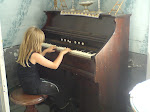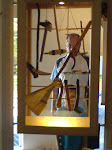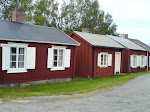A Peter and an Emelie, 6 years, had their first piano-lesson today. Peter turned around on the chair if he got the opportunity, and had problems to sit still!! Short legs, almost not reaching the floor!
“Have you seen that on this keyboard there are black and white keys!? Do you want to play? But there is one thing you must remember: you have to play on black keys only!!”
They sat down at the piano and I started to play an accompaniment on two chords. Both children sat there doing nothing, waiting for each others?
“I don’t know how to do!”
“Test a black key, then you’ll find that everyone suits!!”
At last they started a bit carefully.
“Now, only white keys are allowed!!”
I said.
They switched after some seconds hesitation. And back to the black keys again.
“I have a sort of riddle (rhyming in Swedish): two are black; can you see? And between them is ‘d’! Can you find 'd' now?”
Yes, they could. And we searched d:s over the whole keyboard and counted them. Found seven d:s!!
“And do you know which one is your right hand?”
Peter immediately showed. Emelie hesitated. No, she didn’t quite know!
“I’m left-handed!”
she said.
“Ok”
I replied, “which hand do you say good-day with??”
“This one??”
she showed her left hand. She probably gives her left hand to people when they want to shake hand with her!? :-)
At last she found her right hand, and we put the thumb on a ‘d’ we chose for ourselves. And after that all the other fingers on a white key each. The fifth finger then landed on ‘a’.
“Do you know what this tone is called? It’s ‘a’. Can you play ‘d’ and ‘a’ together?”
I showed them and they played with me. Emelie followed my rhythm (in whole notes). Peter played quarter notes, I let him, and I sang Brother John. As Emelie turned out to be left-handed I asked the children if they could find the chord (‘d’ and ‘a’ together) in the left hand too. Peter took it in both hands, so I let them both do that. And asked the mom’s to sing while we accompanied them on piano.
“Now back to your chairs!”
I said. “Do you know, I am very careful with how my pupils are sitting at the piano.”
I told them how I think one shall sit at the piano, with the whole foot in the floor. On half the chair. They managed this.
And we let our hands hang down. “There you have a very good hand for piano-playing, as when they are just hanging down!!! You can also think that you have a glass-ball under your hands! And now I also want to give the fingers new names, this is one.”
I started singing “one, one, one, one, one”
in a certain rhythm and continued with all the fingers and back to the thumb, starting from the tone ‘d’.
“Now we must check at the piano. How should you sit at the piano - how was it? Oh, good! You could! Excellent! I will write something!”
On a white paper I wrote, first "d, d, e, e, f-sharp, f-sharp, e" and then "f-sharp, f-sharp, e, e, d ,d , d. " And between those I asked:
“Now where are your right hands? And where was 'd'?”
We played the melody I had written. And tried another one.
And at last I said:
“And I use to play technique exercises with all! Can you play ‘tonen d, tonen e, tonen fiss, tonen g, tonen a etc.’”
In English we played "the tone d", e, f-sharp, g and a and back stepwise to d, thus using all the five fingers. A, what we call, portato exercise, and also to start training the names of the first five notes we are going to work with.
They did, but it wasn’t easy! I had forgotten how small 6-years olds actually are! :-)
About the piano here, and about the Grotrian-Steinweg-piano here.





























Inga kommentarer:
Skicka en kommentar